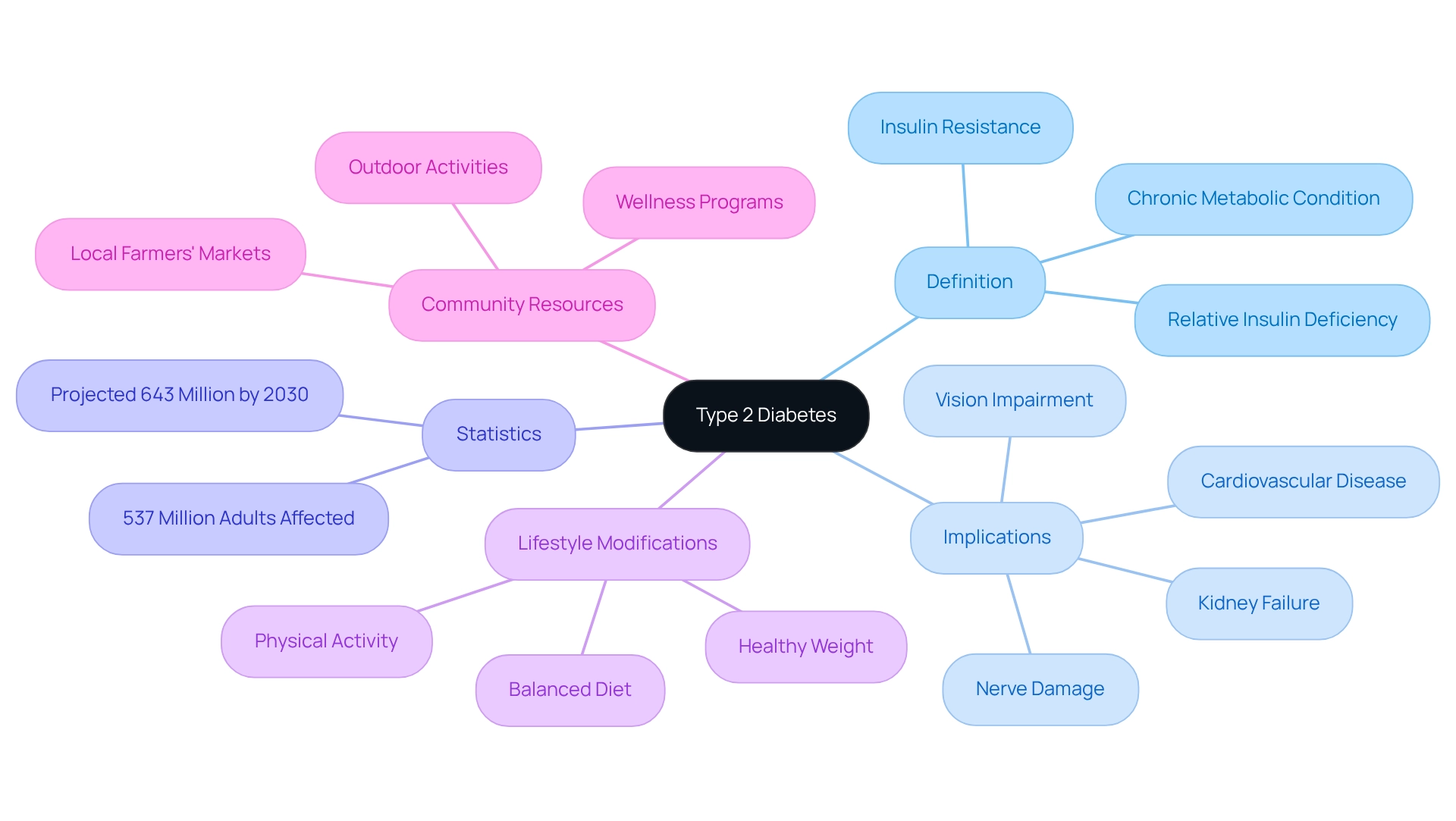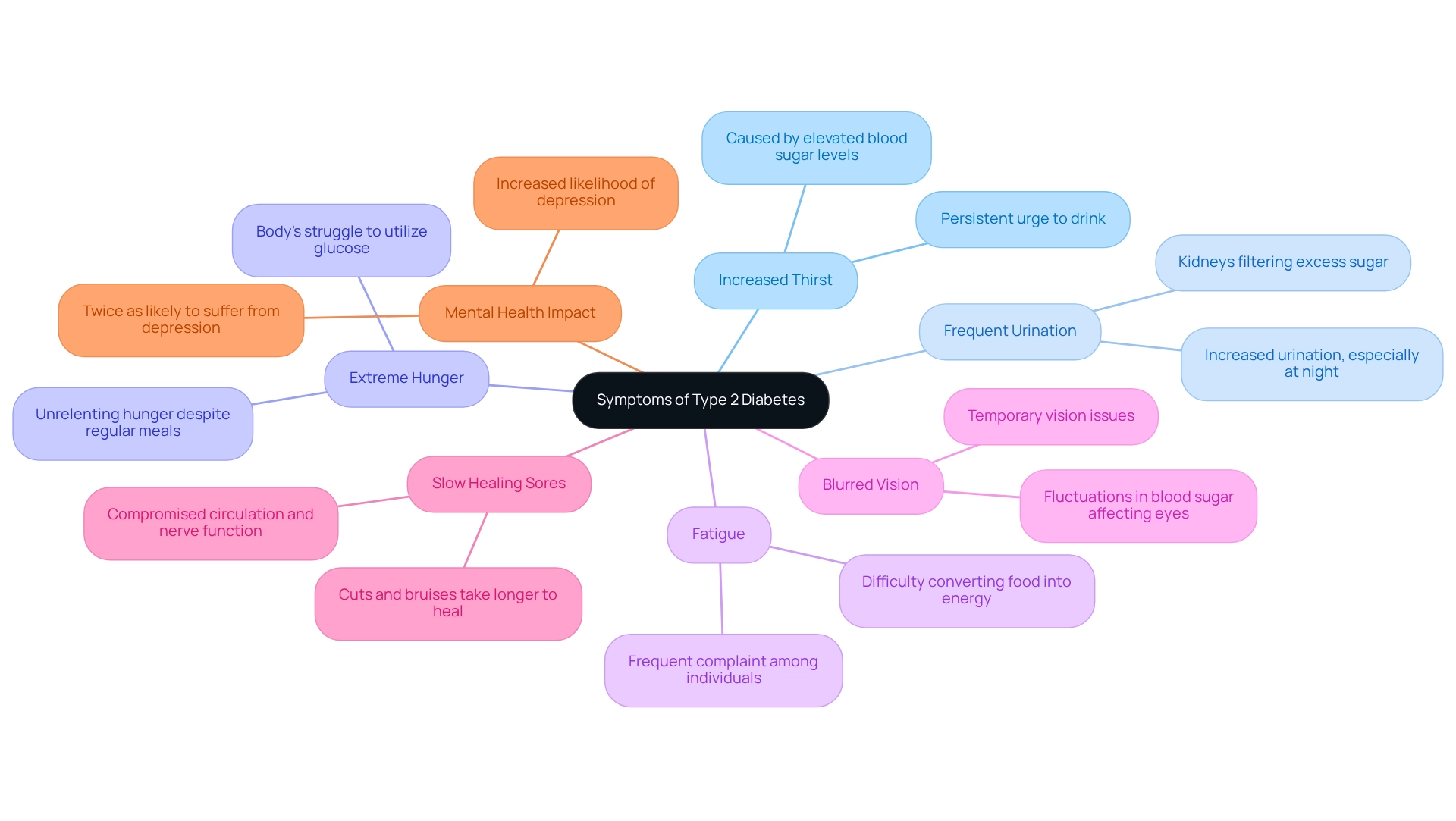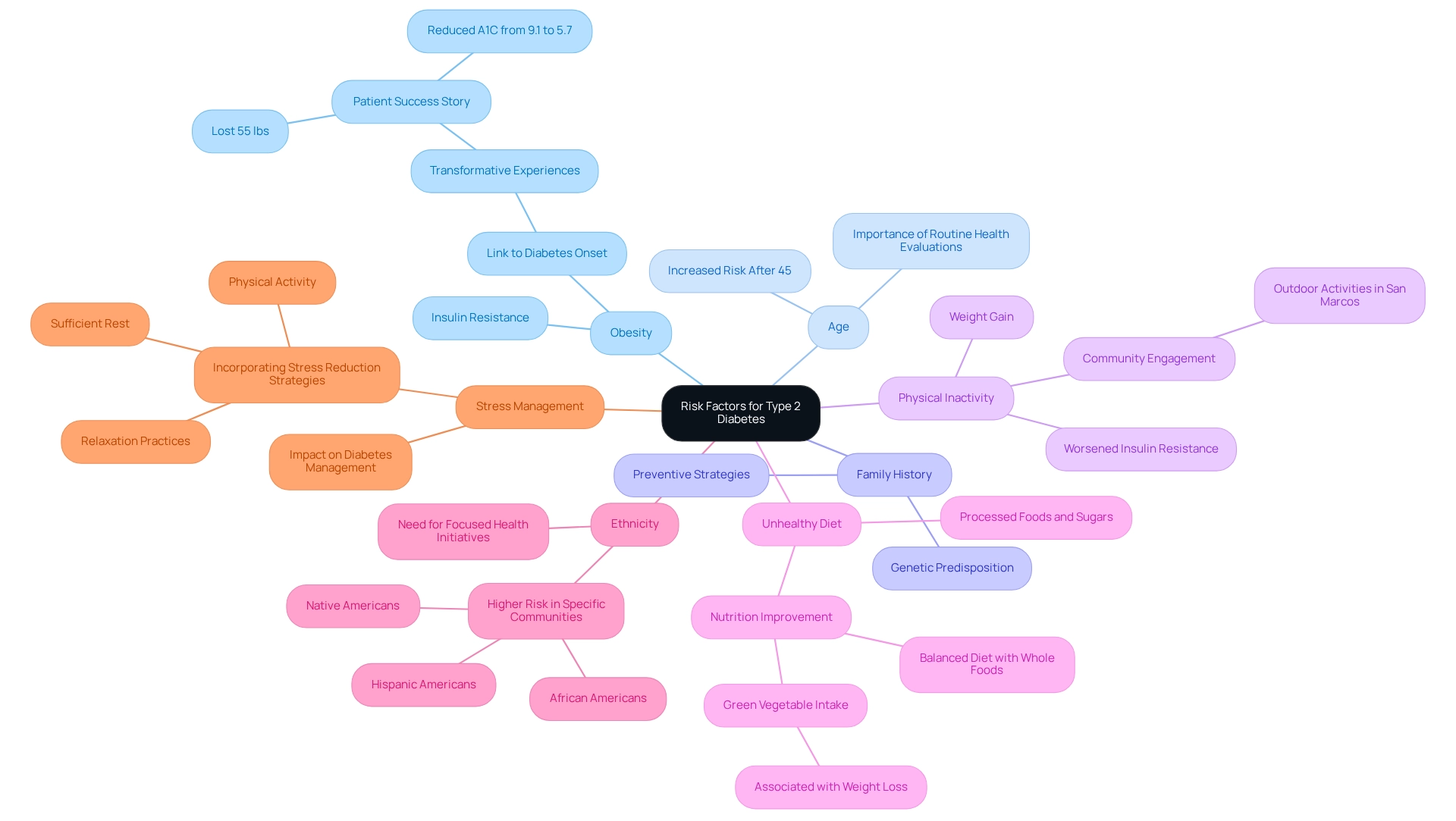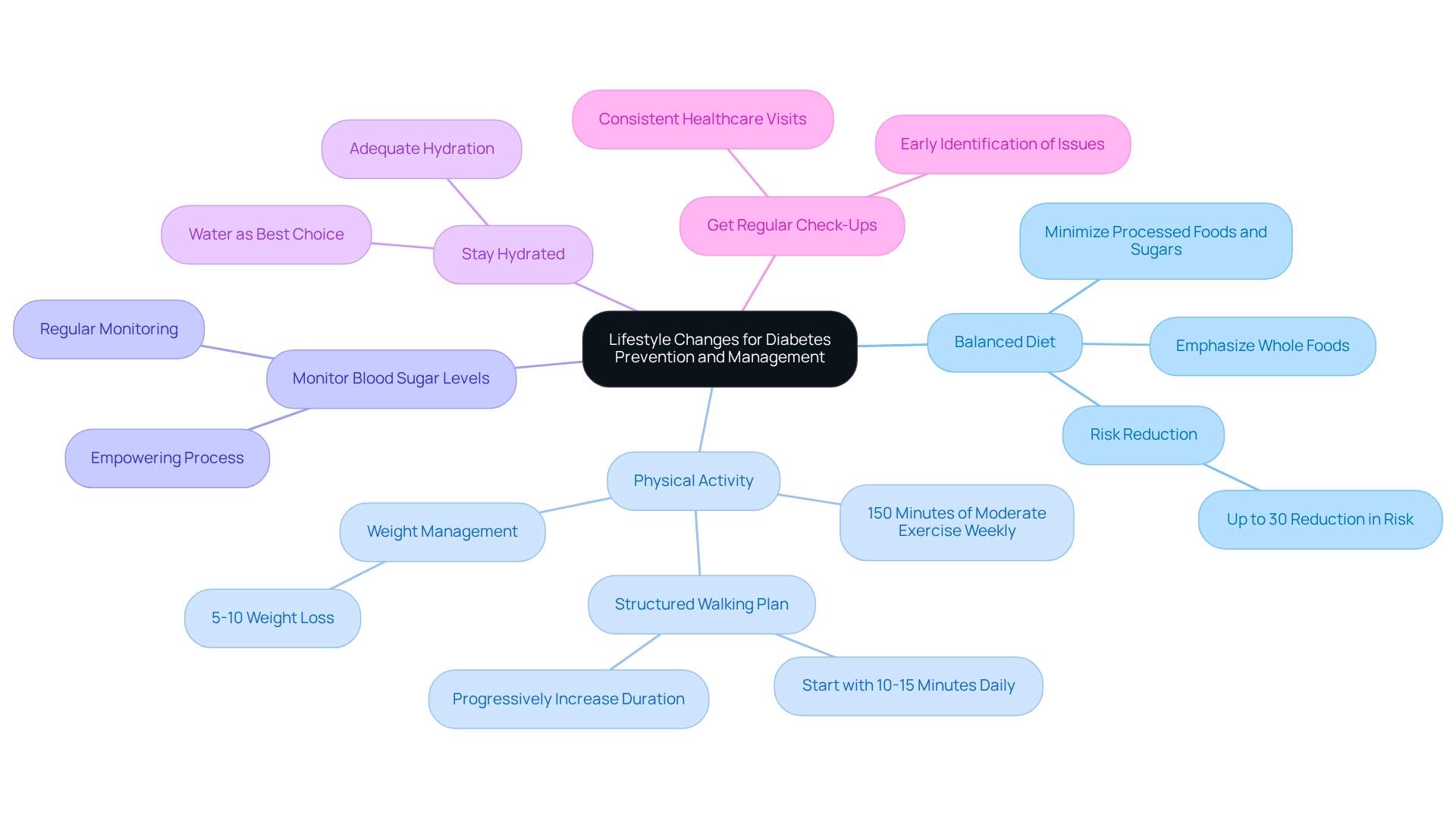Overview
Recognizing the onset of type 2 diabetes can be a challenging journey, and it’s essential to understand the key symptoms and risk factors associated with this condition. Early identification of symptoms like increased thirst, frequent urination, and fatigue is crucial. Many patients find that acknowledging these signs can lead to timely diagnosis and effective management.
It’s important to recognize that risk factors such as obesity and physical inactivity play a significant role in developing diabetes. By understanding these factors, you can take proactive steps toward a healthier lifestyle. Evidence shows that lifestyle changes can significantly reduce your risk of developing diabetes, and this journey begins with awareness.
Imagine how empowering it can be to take control of your health. By focusing on early recognition and understanding your unique risk factors, you can make informed choices that lead to a healthier future. Remember, you are not alone in this; support is available, and positive changes are within reach.
Introduction
In a world where chronic conditions are increasingly prevalent, type 2 diabetes emerges as a significant health challenge that affects millions of individuals worldwide. This condition, characterized by insulin resistance and elevated blood sugar levels, often goes unnoticed until severe complications arise, leaving many feeling overwhelmed and uncertain. It’s important to recognize that approximately 537 million adults are currently living with diabetes—a number that is expected to rise in the years ahead. Understanding the nature, symptoms, and risk factors associated with this condition is crucial for everyone.
Many patients find that gaining insights into effective management strategies and lifestyle changes can empower them to take control of their health. Community support plays a vital role in this journey, especially in places like San Marcos, CA. By fostering a sense of connection and sharing practical tools, we can help individuals reclaim their health and enhance their quality of life amidst this growing epidemic. Together, we can navigate the complexities of type 2 diabetes and inspire a healthier future.
Define Type 2 Diabetes: Understanding Its Nature and Impact
Type 2 diabetes is a chronic metabolic condition that many individuals face, characterized by insulin resistance and a relative deficiency in insulin production, which leads to increased blood glucose levels. Unlike type 1 diabetes, where insulin production is nonexistent, those with type 2 can produce insulin, but their bodies struggle to use it effectively. This condition often develops gradually and can frequently remain undetected for years, which is concerning regarding the onset of type 2 diabetes.
The implications of type 2 diabetes extend far beyond just elevated blood sugar levels. It can lead to serious health complications, such as cardiovascular disease, nerve damage, kidney failure, and vision impairment. Current statistics reveal that around 537 million adults globally are living with this condition, with projections indicating that this number could rise to 643 million by 2030. This alarming trend highlights the urgent need for early detection and proactive management strategies.
It’s important to recognize that addressing insulin resistance is crucial. Dr. Jason Shumard emphasizes, “By offering patients actionable insights and practical tools, the center cultivates an atmosphere where individuals can regain their wellness and well-being, ultimately enhancing their quality of life and reducing dependence on traditional medical interventions.” Research shows that lifestyle modifications—such as maintaining a healthy weight, engaging in regular physical activity, and adopting a balanced diet—can significantly reduce the risk of the onset of type 2 diabetes. Many patients who implement these changes experience substantial improvements in their wellness metrics, including blood sugar levels and overall well-being.
In San Marcos, CA, adopting a holistic lifestyle can be particularly beneficial in preventing the onset of type 2 diabetes. Engaging in outdoor activities, such as hiking at Lake San Marcos or walking the trails at Discovery Lake, not only boosts physical fitness but also enhances mood and insulin sensitivity. Local farmers’ markets provide access to fresh, nutritious produce, which is essential for a diabetes-friendly diet. Including seasonal fruits and vegetables, like avocados and leafy greens, can help regulate blood sugar levels and promote overall well-being.
Moreover, community wellness programs in San Marcos offer invaluable resources for managing blood sugar levels, thereby reducing the risk of the onset of type 2 diabetes. These programs often provide education on nutrition and fitness, along with support from others facing similar challenges. Real-world experiences illustrate the impact of insulin resistance on health. Individuals with this condition may face fatigue, increased thirst, and frequent urination, which can diminish their quality of life. Recent research underscores the importance of routine evaluations with medical experts to ensure thorough management of blood sugar issues, as addressing factors that increase the risk of complications can effectively lower the likelihood of their emergence.
In summary, understanding the characteristics and challenges associated with type 2 diabetes is vital for early identification and effective management. By recognizing the signs and embracing lifestyle changes, individuals can take proactive steps toward reclaiming their health and reducing the risk of serious complications. The evolving healthcare landscape, which increasingly incorporates alternative treatment options like Dr. Shumard’s 30-Day Reset program, further underscores the need for a comprehensive approach to managing this condition. For personalized guidance and support tailored to your unique needs, consider reaching out to Dr. Shumard in San Marcos, CA.
Identify Symptoms of Type 2 Diabetes: Early Warning Signs to Recognize
Common symptoms of type 2 diabetes can include various physical signs that significantly impact daily life, especially at the onset of type 2 diabetes. It’s important to recognize these key symptoms:
- Increased thirst: Many individuals find themselves with a persistent urge to drink more fluids, stemming from elevated blood sugar levels.
- Frequent urination: The kidneys work hard to filter out excess sugar, leading to increased urination, especially noticeable at night.
- Extreme hunger: Despite having regular meals, many experience unrelenting hunger due to the body’s struggle to utilize glucose effectively.
- Fatigue: A frequent complaint, fatigue arises from the body’s difficulty in converting food into usable energy.
- Blurred vision: Fluctuations in blood sugar can cause temporary vision issues due to fluid changes in the eyes.
- Slow healing sores: Cuts and bruises may take longer to heal due to compromised circulation and nerve function.
Recognizing these symptoms early is crucial for understanding the onset of type 2 diabetes. Studies show that individuals with diabetes are twice as likely to experience depression compared to those without the condition. This highlights the importance of addressing both physical and mental wellness aspects. Many patients who identify these symptoms early report significant improvements in their well-being through proactive management strategies. For example, one patient at Dr. Shumard’s center recognized their symptoms early and benefited from a holistic approach, leading to remarkable improvements in their overall health.
Experts emphasize that awareness of these early warning signs can lead to timely diagnosis and intervention, ultimately reducing the risk of the onset of type 2 diabetes and other severe complications. As Dr. Jason Shumard states, “By offering patients actionable insights and practical tools, the center nurtures an atmosphere where individuals can regain their wellness and well-being.” By fostering a setting of learning and empowerment, individuals can reclaim their well-being and enhance their quality of life.
Explore Risk Factors for Type 2 Diabetes: Understanding Your Vulnerability
Several key risk factors contribute significantly to an individual’s vulnerability to the onset of type 2 diabetes.
-
Obesity: Excess body fat, particularly around the abdomen, is a major contributor to insulin resistance, significantly increasing the likelihood of developing diabetes. Recent data shows a significant link between increasing obesity rates and the onset of type 2 diabetes, emphasizing the need to address this public welfare concern. Many patients find that transformative experiences from Dr. Jason Shumard’s 30-Day Diabetes Reset program reveal that individuals who commit to lifestyle changes can achieve remarkable results. One patient shared, “I lost 55 lbs and reduced my A1C from 9.1 to 5.7 after participating in the program.”
-
It’s important to recognize that the likelihood of developing the onset of type 2 diabetes increases with age, especially after 45. This age-related threat highlights the significance of routine health evaluations as people age.
-
A family history of this condition can substantially elevate an individual’s risk for the onset of type 2 diabetes, indicating a genetic predisposition that warrants attention in preventive strategies.
-
Physical inactivity not only leads to weight gain and worsens insulin resistance but also increases the risk for the onset of type 2 diabetes, making regular physical activity crucial for prevention. Engaging in outdoor activities, as highlighted in the San Marcos community, can significantly enhance physical fitness and overall well-being. As Jack LaLanne famously stated, “Exercise is king; nutrition is queen. Put them together and you’ve got a kingdom.”
-
An unhealthy diet, which includes high amounts of processed foods, sugars, and unhealthy fats, is linked to obesity and the onset of type 2 diabetes through glucose intolerance. Nutritionists stress that enhancing eating habits can greatly lower the chance of developing health issues. Patients in Dr. Shumard’s program have reported feeling better and experiencing reduced medication needs after adopting a balanced diet rich in whole foods and local produce.
-
Ethnicity: Specific ethnic communities, such as African Americans, Hispanic Americans, and Native Americans, encounter an increased likelihood of developing type 2 diabetes, highlighting the necessity for focused health initiatives.
Grasping these risk factors enables individuals to make knowledgeable lifestyle decisions that can reduce their likelihood of the onset of type 2 diabetes. Moreover, managing stress through methods like physical exercise, sufficient rest, and relaxation practices has been demonstrated to enhance overall health management and improve quality of life. Community wellness initiatives in San Marcos provide invaluable assistance for managing blood sugar levels, offering resources and group support customized to personal requirements. A case study titled “Impact of Stress on Diabetes Management” emphasizes that stress can complicate the management of this condition, making it essential to incorporate strategies for stress reduction. By recognizing the interplay between obesity, age, and lifestyle factors, individuals can take proactive steps toward better health, as demonstrated by the success stories from Dr. Shumard’s program.
Implement Lifestyle Changes: Strategies for Prevention and Management
To effectively prevent or manage type 2 diabetes, consider implementing the following lifestyle changes:
- Adopt a Balanced Diet: It’s important to emphasize whole foods such as fruits, vegetables, whole grains, lean proteins, and healthy fats. Minimizing processed foods and sugars is essential. Research shows that dietary adjustments can greatly decrease the likelihood of the onset of type 2 diabetes. For instance, individuals who adopt a diet rich in whole foods can reduce their risk at the onset of type 2 diabetes by up to 30%.
- Increase Physical Activity: Many patients find that aiming for at least 150 minutes of moderate-intensity exercise weekly, including activities like brisk walking, cycling, or swimming, is beneficial. A structured walking plan can be especially advantageous; beginning with a daily stroll of 10-15 minutes and progressively increasing duration and frequency can improve overall well-being. Regular physical activity not only aids in weight management but also improves insulin sensitivity and blood sugar control. As Tiffany Danczak wisely stated, “Don’t let yourself fall, you gotta pick yourself right up and strive to do better and be better!” Additionally, many participants in Dr. Jason Shumard’s 30-Day Diabetes Reset program have reported significant improvements in their health through similar lifestyle changes. Maintaining a healthy weight is essential, as even modest weight loss—around 5-10% of body weight—can significantly reduce the likelihood of the onset of type 2 diabetes. This is particularly important as obesity is a major risk factor for the onset of type 2 diabetes. Case studies from the ‘Natural Healing Retreat’ demonstrate that attendees who embraced lifestyle changes experienced significant improvements in their well-being outcomes.
- Monitor Blood Sugar Levels: Regularly checking blood sugar levels helps individuals understand how their lifestyle choices impact their health. This proactive approach can lead to better management and prevention strategies for the onset of type 2 diabetes. The proper mindset can change the experience of managing this condition, making monitoring a more empowering process.
- Stay Hydrated: Adequate hydration is essential for managing blood sugar levels and curbing hunger. Water is the best choice, as it contains no calories or sugars.
- Get Regular Check-Ups: Consistent visits to healthcare providers are vital for monitoring risk factors and identifying potential issues early on. This can result in prompt actions that may avert the development of the condition.
By adopting these strategies, individuals can take significant steps toward improving their health and effectively managing diabetes. Real-world examples demonstrate that those who commit to these lifestyle changes often experience transformative results, enhancing their overall quality of life. For personalized guidance and support tailored to your unique needs, consider reaching out to Dr. Jason Shumard in San Marcos, CA.
Conclusion
Type 2 diabetes presents a significant health challenge, affecting millions around the world and often remaining undetected until serious complications arise. It’s crucial to understand its nature, symptoms, and risk factors for effective management. Early detection and proactive lifestyle changes are vital, as individuals can truly reclaim their health through informed choices.
Have you noticed symptoms such as increased thirst, fatigue, or blurred vision? Recognizing these signs can lead to timely diagnosis and intervention. Additionally, understanding risk factors like obesity, age, and family history empowers you to make lifestyle adjustments that can reduce your vulnerability to this condition. Embracing a balanced diet, engaging in regular physical activity, and maintaining ongoing health monitoring can significantly enhance your health outcomes.
In communities like San Marcos, CA, local resources and support systems are invaluable in managing type 2 diabetes. By fostering connections and sharing practical tools, individuals can navigate their health journeys more effectively. It’s important to recognize that collective efforts to address this growing epidemic can inspire a healthier future for everyone. Through awareness and community engagement, a proactive approach to managing type 2 diabetes is not just possible but truly achievable.
Frequently Asked Questions
What is type 2 diabetes?
Type 2 diabetes is a chronic metabolic condition characterized by insulin resistance and a relative deficiency in insulin production, leading to increased blood glucose levels. Unlike type 1 diabetes, individuals with type 2 can produce insulin but struggle to use it effectively.
How does type 2 diabetes develop?
Type 2 diabetes often develops gradually and can remain undetected for years, which is a concern due to its potential health implications.
What are the health complications associated with type 2 diabetes?
Type 2 diabetes can lead to serious health complications, including cardiovascular disease, nerve damage, kidney failure, and vision impairment.
How many adults are affected by type 2 diabetes globally?
Approximately 537 million adults worldwide are living with type 2 diabetes, with projections suggesting this number could rise to 643 million by 2030.
What lifestyle modifications can help reduce the risk of type 2 diabetes?
Maintaining a healthy weight, engaging in regular physical activity, and adopting a balanced diet are lifestyle modifications that can significantly reduce the risk of developing type 2 diabetes.
How can outdoor activities in San Marcos, CA, help prevent type 2 diabetes?
Engaging in outdoor activities like hiking and walking can boost physical fitness, enhance mood, and improve insulin sensitivity, which are beneficial in preventing type 2 diabetes.
What resources are available in San Marcos for managing blood sugar levels?
Community wellness programs in San Marcos offer education on nutrition and fitness, along with support from others facing similar challenges, which can help manage blood sugar levels.
What are some common symptoms experienced by individuals with insulin resistance?
Individuals with insulin resistance may experience fatigue, increased thirst, and frequent urination, which can affect their quality of life.
Why is it important to have routine evaluations with medical experts for type 2 diabetes management?
Routine evaluations with medical experts are crucial for thorough management of blood sugar issues and for addressing factors that increase the risk of complications.
What is the significance of embracing lifestyle changes for individuals at risk of type 2 diabetes?
Embracing lifestyle changes can help individuals proactively reclaim their health and reduce the risk of serious complications associated with type 2 diabetes.



